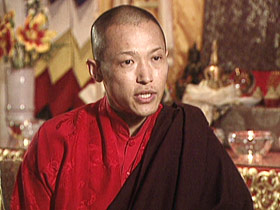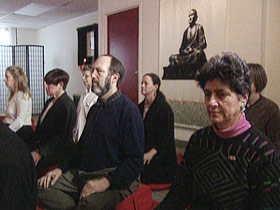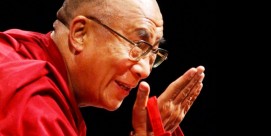In This Episode << SLIDE LEFT TO SEE ADDITIONAL SEGMENTS
Shambhala Meditation
BOB ABERNETHY, anchor: Buddhist meditation techniques are widely popular, and one such method is called Shambhala meditation, a simplified version of Tibetan practice. Recently, Sakyong Mipham Rinpoche, author and meditation leader, told a group of beginners to relax, note their breathing, set aside their thoughts, and just be — quietly — who they are. The setting was All Souls Unitarian Church in Washington, D.C.

SAKYONG MIPHAM RINPOCHE (Spiritual Leader, Shambhala Buddhist Movement): “Shambhala” is a word that really connotes how a human being can live in the world and practice spirituality and not renounce anything, in a sense. It’s a notion that one can have a family, one could have a job, and one can still deepen and meditate and understand. And that life is a journey and that one does not have to become a renunciator or monastic in order to do that.
In Shambhala one needs to have what we call “windhorse” — developing your life-force energy. People struggle in their life — working, just getting through the day, trying so many things just so that they are able to survive. And they need energy, and they need strength. Discord and argument weaken our energy.
Meditation to me is strengthening the mind. In the Buddhist tradition, we say, in order just to feel a sense of joy — the word is “dewa,” bliss, happiness — one needs sleep, one needs food, one needs meditation, and one needs well-beingness. What I find interesting about this particular list, as it were, is that meditation is thrown in there. Just like you take care of the body, just like you need to sleep, at some point one needs to meditate. And that means a period in the day when one can strengthen, calm, and then you’re ready. Otherwise, life becomes overwhelming, and the level of agitation and stress begins to reduce our energy.

Meditation really doesn’t have to take more than five or ten minutes. It’s better to do ten minutes than not to really focus and drag on for an hour. If one wants to meditate longer, great. But really the notion is consistency — just some time in the day when you reflect.
The word “meditation” in Tibetan is “gom,” and it means “familiarity.” So what do we become familiar with now? Our breathing. We’ll just breathe. So, everybody can breathe?
Whatever our thoughts are, those little ones, those are okay. Thoughts that are engrossing about the future, going over stories of the past where it takes us away totally from this room, those we should recognize that we are drifting and come back to the breathing.
We’re just trying to be at peace. Rest comfortably. And every time we rest, every time we follow the breathing, feel the breathing, our mind becomes stronger.
And, once we begin to strengthen, and our mind begins to settle down, then we’re able to perceive things in a deeper way. We begin to look and say, “What about love, what about compassion, what about the notions of egolessness or selflessness?” Those insights don’t come very often.
At a very basic level, every single sentient being is the Buddha. You discover the Buddha, as opposed to you become the Buddha.
Enlightenment is that rediscovery, you can say. And the process of meditation is sort of like cleaning a window — you finally get to see through.







